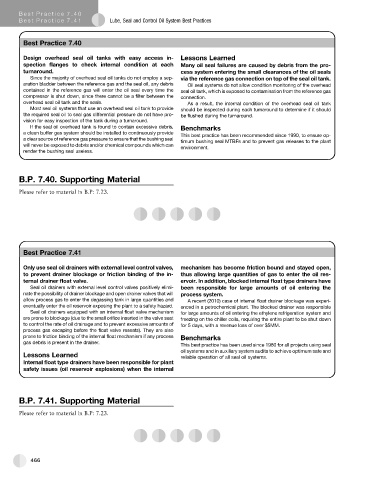Page 495 - Subyek Teknik Mesin - Forsthoffers Best Practice Handbook for Rotating Machinery by William E Forsthoffer
P. 495
Be st Practice 7 .40
Be st Practice 7 .41 Lube, Seal and Control Oil System Best Practices
Best
Best Practice 7.40Practice 7.40
Design overhead seal oil tanks with easy access in- Lessons Learned
spection flanges to check internal condition at each Many oil seal failures are caused by debris from the pro-
turnaround. cess system entering the small clearances of the oil seals
Since the majority of overhead seal oil tanks do not employ a sep- via the reference gas connection on top of the seal oil tank.
aration bladder between the reference gas and the seal oil, any debris Oil seal systems do not allow condition monitoring of the overhead
contained in the reference gas will enter the oil seal every time the seal oil tank, which is exposed to contamination from the reference gas
compressor is shut down, since there cannot be a filter between the connection.
overhead seal oil tank and the seals. As a result, the internal condition of the overhead seal oil tank
Most seal oil systems that use an overhead seal oil tank to provide should be inspected during each turnaround to determine if it should
the required seal oil to seal gas differential pressure do not have pro- be flushed during the turnaround.
vision for easy inspection of the tank during a turnaround.
If the seal oil overhead tank is found to contain excessive debris, Benchmarks
a clean buffer gas system should be installed to continuously provide
This best practice has been recommended since 1990, to ensure op-
a clear source of reference gas pressure to ensure that the bushing seal timum bushing seal MTBFs and to prevent gas releases to the plant
will never be exposed to debris and/or chemical compounds which can environment.
render the bushing seal useless.
B.P. 7.40. Supporting Material
Please refer to material in B.P: 7.23.
Best Practice 7.41Practice 7.41
Best
Only use seal oil drainers with external level control valves, mechanism has become friction bound and stayed open,
to prevent drainer blockage or friction binding of the in- thus allowing large quantities of gas to enter the oil res-
ternal drainer float valve. ervoir. In addition, blocked internal float type drainers have
Seal oil drainers with external level control valves positively elimi- been responsible for large amounts of oil entering the
nate the possibility of drainer blockage and open drainer valves that will process system.
allow process gas to enter the degassing tank in large quantities and A recent (2010) case of internal float drainer blockage was experi-
eventually enter the oil reservoir exposing the plant to a safety hazard. enced in a petrochemical plant. The blocked drainer was responsible
Seal oil drainers equipped with an internal float valve mechanism for large amounts of oil entering the ethylene refrigeration system and
are prone to blockage (due to the small orifice inserted in the valve seat freezing on the chiller coils, requiring the entire plant to be shut down
to control the rate of oil drainage and to prevent excessive amounts of for 5 days, with a revenue loss of over $5MM.
process gas escaping before the float valve reseats). They are also
prone to friction binding of the internal float mechanism if any process Benchmarks
gas debris is present in the drainer.
This best practice has been used since 1980 for all projects using seal
oil systems and in auxiliary system audits to achieve optimum safe and
Lessons Learned reliable operation of all seal oil systems.
Internal float type drainers have been responsible for plant
safety issues (oil reservoir explosions) when the internal
B.P. 7.41. Supporting Material
Please refer to material in B.P: 7.23.
466

